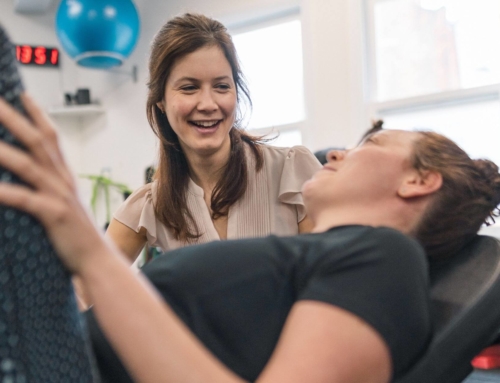So you’re going back to the gym after a long break? Whether you’ve been away for a few months or a year, getting back to your gym and fitness routine can be challenging. Learn how to avoid common injuries like lower back pain, wrist pain, and elbow pain with these tips. Our main message is that you need to set a solid foundation for yourself to get back to training. Don’t just jump straight back in where you left off, that is a guaranteed recipe for injury!
Here are our most common questions answered to maximise your chances of a safe and effective return to the gym.
How often should you workout?
When returning to the gym after a long break, give yourself at least 48 hours between training sessions or limit yourself to 3 gym sessions a week for the first 2 weeks. This will give all of your tissues time to adapt to the higher load you are placing on them, thus reducing the risk of gym injuries such as tennis elbow or lower back pain after the gym.
How much weight should I lift after a break from the gym?
After a lay-off from the gym drop your weight to 50% of what you were doing before your break. From there you can increase by a set percentage each week. Your early focus should be on form, not high loading/intensity.
If you have remained somewhat active during the lockdown, a 15% increase per week should be achievable, meaning you will be back to your full weights at week 4.
If you have been away from the gym for more than 6 months, stick to a 10% increase per week, meaning week 6 should be the first week you are anywhere near your previous lifts.
Remember the goal is to return to the gym and stay there, Don’t ego lift and pick up a new gym injury in the first few weeks.
How to safely increase your workout intensity after a break?
Instead of focusing on numbers, gauge your reps by intensity levels. If 10/10 is full intensity, meaning failure, then start at 6/10 intensity and increase by no more than 1/10 per week, as a guide.
- 10/10 = failure
- 9/10 = 1 more rep could be performed
- 8/10 = 2 more reps could be performed
- 7/10 = 4 more reps
- 6/10 = 6 more reps
How to improve recovery after returning to the gym?
Sleep and eat well. Sleep is by far the best recovery tool known to man, it’s also free and enjoyable! Getting your 7-9 hours in is important at all times but especially when exercising.
Further to this, if your calorie output through exercise goes up, you need to give your body the nutrients to recover from the higher level of exercise. Of course, if during your time away from exercise you may have gained a few pounds, a responsible calorie deficit is the best way to safely take them off.
How to improve recovery after returning to the gym?
Be very considerate with re-starting plyometrics. Any jumping, hopping or skipping tasks should be re-added cautiously. By far the biggest loads on tendons and bones are through plyometric exercises and as outlined above, these can take 72 hours to recover from.
If you have stayed active but not doing plyometric exercise through your break from the gym, limit these activities to twice a week and limit foot contacts (i.e. how many times your foot hits the ground) to 40 each foot, then increase by no more than 10% weekly. If you have been inactive over lockdown, wait until week 3 of your gym return and follow the guidelines above.
What if I pick up a gym injury?
Respect any niggles and see your physio if any pain persists. If you start to feel any pain on your return to the gym, try not to aggravate that area any further, seek a professional opinion ASAP to get it sorted. This will ensure you don’t pick up a new injury and will get you back on track as fast as possible..
The extent to which muscle strength decreases over a period of months is not fully understood, particularly in recreational trained athletes/gym-goers. However, a 2013 Meta-Analysis by McMaster & colleagues found that in elite rugby and American Football athletes, there was a 19% decrease in overall strength in breaks between 10-16 weeks and a 40% reduction in shoulder strength.
It’s important to remember that tendons and bones change with exposure to loading, and it takes around 48-72 hours for these tissues to recover from heavy loading, particularly plyometric loading (i.e. jumping). So, it’s important to have a steady return to exercise, particularly at high intensity and give respect to the recovery time of your body.Hopefully, these tips will guide you through a safe and injury-free return to the gym. If a physiotherapy assessment is required, plese don’t hesitate to get in touch.
Going back to the gym? Book a sports massage to aid in recovery after your workouts. Our therapists can help reduce muscle soreness and improve range of motion. Don’t let pain hold you back, book now!
Don’t let pain hold you back, book now!




